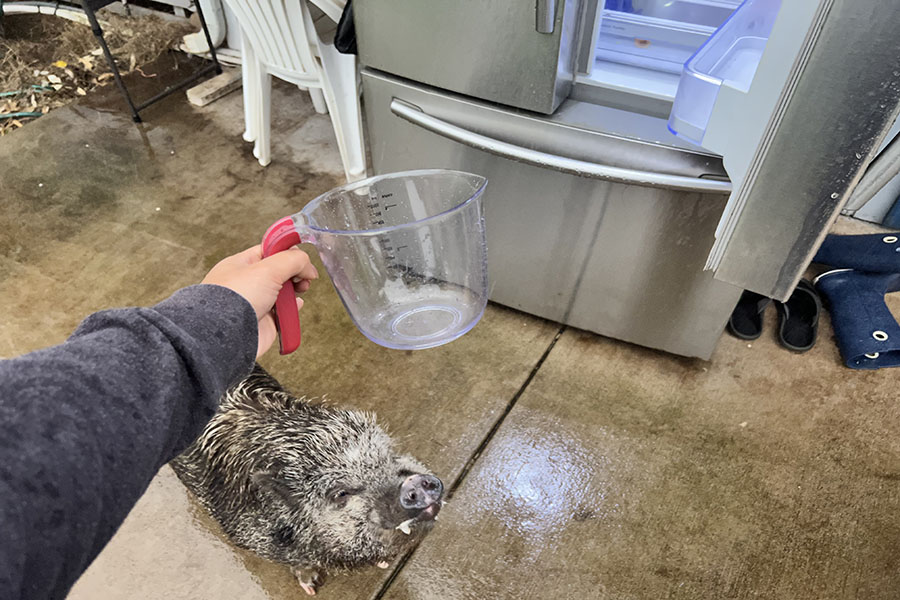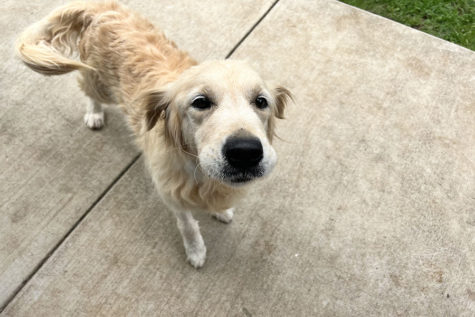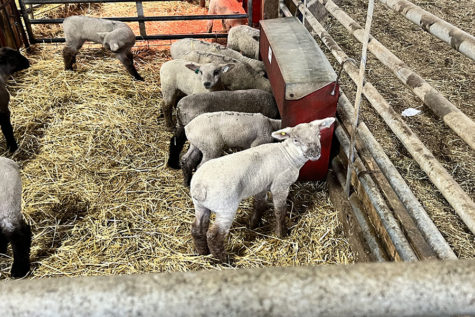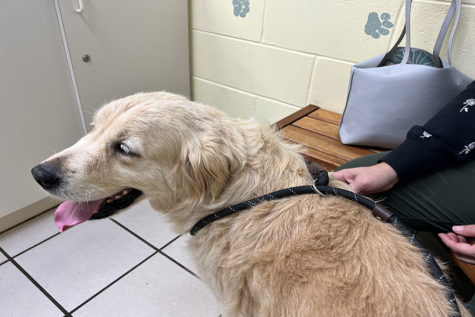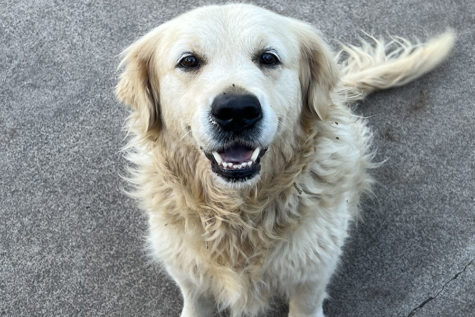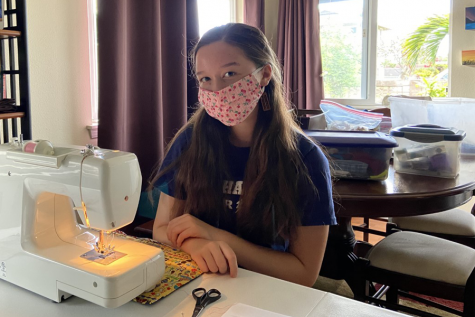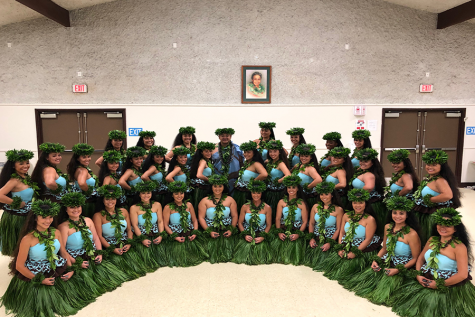Kira’s Companions: ‘The complexity of pigs’
Photo by Kira Gomez
Arnold, my Juliana pig, munches on celery that I sometimes use as reward or for bonding Just as my research showed, Arnold has proven to be a curious and intelligent companion.
March 22, 2023
Last Thursday , I presented an informative speech for my COM 2000 class. We got to choose any topic we wanted, and I knew right away I wanted to speak about animals. After brainstorming, I decided on researching about pigs. I wanted to show my audience that there is so much more that makes up a pig’s mind than we think. I explained this from both research and personal experience using my own pig, Arnold.
There have been many famous pigs throughout time, Wilbur from Charlotte’s Web, Miss Piggy from the Muppets, and the pig my own pig is named after, Arnold Ziffle from Green Acres, a popular show from the 1960s that my mom used to watch. Did you know though, that those pigs showcase some of the many fascinating qualities of a real pig? My own pig, Arnold, can testify to that.
While they are a completely different species from humans, pigs are more similar to us than we think. We share more DNA with pigs than we do with our own dogs, and they are more than the kalua pig we eat, more than those animals on the sides of our highways, and more than just creatures that roll around in the mud with no thoughts going through their minds. Their cognition, social capabilities, and emotional intelligence, make them lifelong friends, not just a source of food.
First, most of you know that pigs are smart, but what does that really mean? Pigs have cognitive capabilities similar to young children, meaning their ability to acquire, store, process, recall, and use information. There are several parts that make up their cognitive capabilities. One of them is object discrimination, and it’s a huge part of the decisions we make. Pigs are able to do what we do on a daily basis, such as choosing a carrot over lettuce, choosing a specific tool to do what they need to do, and even knowing what is good and bad for them.
Colvin and Marino, specialists in animal behavior and intelligence, wrote about the the cognitive complexity of the domestic pig. They found that, like dolphins, chimpanzees, and other great apes, pigs possess symbolic language comprehension. In one study published by Ohio State University, two pigs showed they understood gestures and verbal symbols that represent objects such as a ball and dumbbell, as well as actions such as sit, fetch, and jump.
I follow a pig and his owner, Mina, on Instagram and watch as Merlin learns new skills. In one video, Merlin is asked to distinguish among different colors. I noticed that when he did so correctly, he was given a treat. That’s because pigs also love their food, so how do they acquire it on their own? Spatial learning and memory. They are foragers. They learn, remember and apply information about their environment to locate different objects.
My pig, Arnold, has our entire yard mapped out. He knows his pellets come from the shed on the side of the house, and I now expect the doors to always be nudged open when I go outside. He knows his veggies are held in our outside fridge, so if he hears the fridge get opened, he’s there a few seconds later. His nose is always dirty from rooting, and there are specific areas in our yard that are worn down and have holes in them because of his motivation for food.
But why doesn’t Arnold wait for me to open the door for him? Because pigs are extremely independent, and it’s most noticeable when they problem solve. A study done under the Hungarian Ethology Foundation found out that when comparing dogs and pigs, the dogs were more dependent on humans, whereas pigs were more persistent in solving problems on their own. That is one of the reasons why dogs have much better success with developing relationships with humans, but just because pigs have a harder time forming relationships with us, doesn’t mean they aren’t social.
Pigs are born wild with a prey-like mindset unlike dogs, who are born tame. They need time to adjust to their owners, and this comes with constant handling and interaction. The American Mini Pig Association advises that an effective way to socialize with your pig can be floor time–staying close to the ground and doing little things like giving them food or gently petting or scratching them, all while not rushing them or getting frustrated.
Some pigs are less trusting than others. I’m not sure where Arnold falls on that spectrum. He was hesitant in the beginning, but holding him wasn’t that big of an issue thanks to his breeder. I spent a lot of time lying next to him on the other side of his pen and scratching his belly. I was his go-to person. If someone else tried to call for him or carry him, he wouldn’t like it. This is because they can distinguish between different people and animals.
In a study conducted in 2001 and published by the National Library of Medicine, pigs were presented with two different people. One was known as someone who rewarded them with food during the two weeks prior, and the other one wasn’t. They chose the rewarder pretty much every single time. When the two individuals wore the same clothes, the pigs still chose the rewarder, and when the pigs couldn’t see a person’s face, they chose the rewarder less often. It was concluded that they were more sensitive to physical features of personal identity.
Last, pigs are emotionally complex animals that are aware of what they feel and need more mental and emotional stimulation than you may think. Have you ever heard the sounds a pig can make? Let’s just say some are cute, while some are essentially scary and dramatic.
An international team of researchers has translated pig grunts into emotions. This was done in both commercial and experimental scenarios. Here are some of their findings: there were more screams or squeals in negative situations. In positive situations, the calls or grunts are far shorter, with minor fluctuations in amplitude, and barks and grunts were both recorded in positive and negative situations.
Here are examples of these sounds from Arnold. Positive when I am about to give him food, and negative when I am trying to take that food away from him.
That squeal he used to do every morning when he needed to use the bathroom outside and eat is what made me repeat, “No, no, no, not again,” when I was still half asleep just a few feet away from him, but it is with the discovery of pigs’ emotional intelligence, that producers can minimize harm.
Candace Croney, professor and director of the Center for Animal Welfare Science at Purdue University, wrote about how boredom and frustration due to unfulfilled mental needs. Barren environments provide inadequate mental stimulation may lead to undesirable behaviors, such as redirection of normal oral behavior. This results in biting and chewing on available objects, such as the ears and tails of other pigs.
This is detrimental to their welfare because pigs are playful creatures and have the capability of either anticipating exciting activities, such as toys or food, or dreading what is to come in less stimulating conditions. It’s important to pay attention to pigs’ behavior because it will show you what is going on in their heads.
Ultimately, pigs are complex creatures. They have cognitive, social, and emotional abilities similar to our own. These make them not only a highlight in the scientific world where they are used in studies and research, but also my own world through personal experience.
I plan on majoring in animal science with a pre-vet emphasis, but just because this was an assignment, doesn’t mean my journey is over. As I think you can tell by this blog, the topic of our animal companions not only fascinates me, but inspires me to go out and learn more about the animals around us, and as I learn more, I hope you are learning too.


